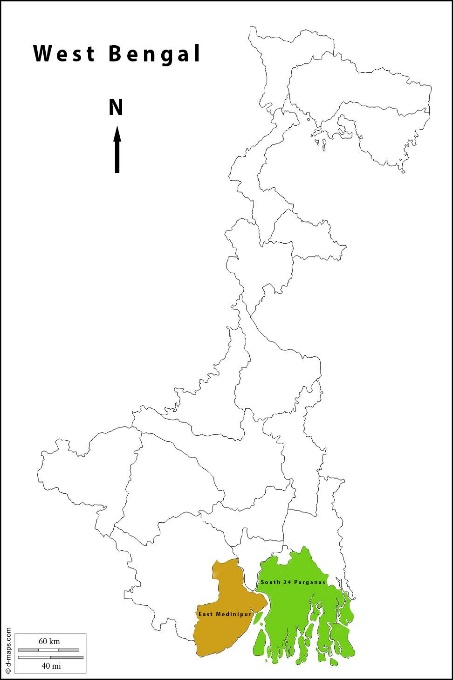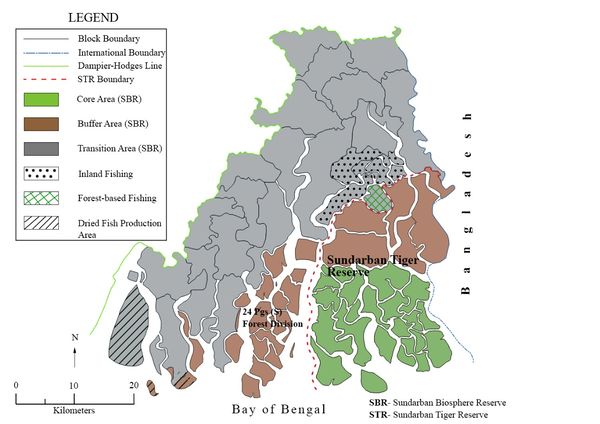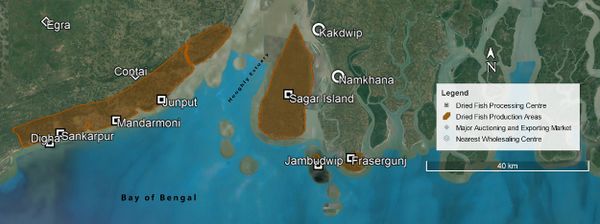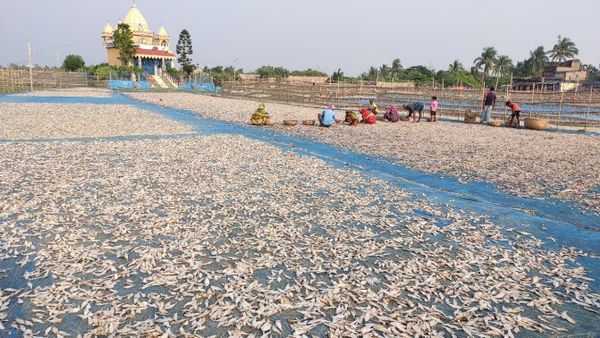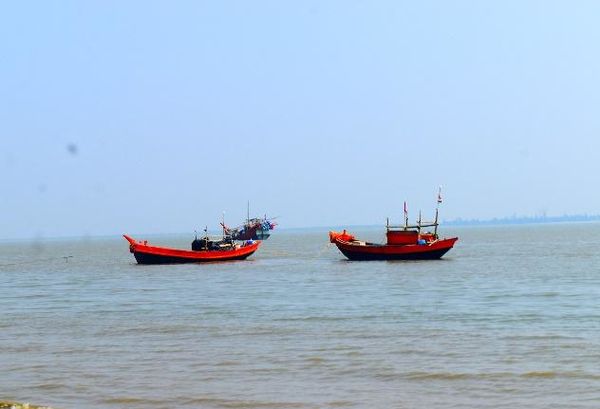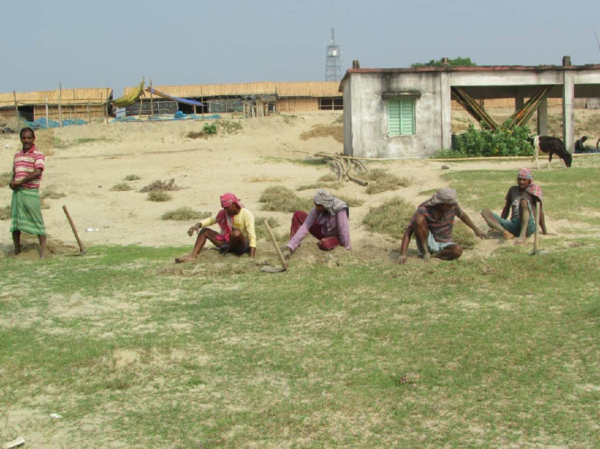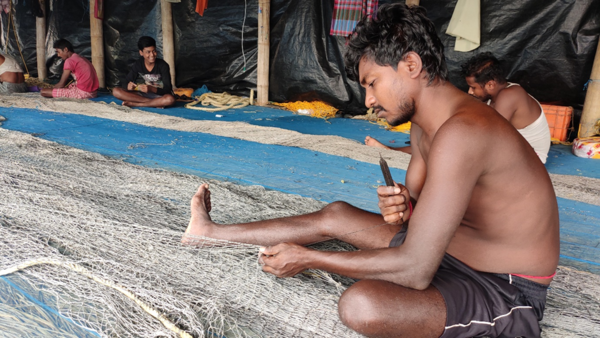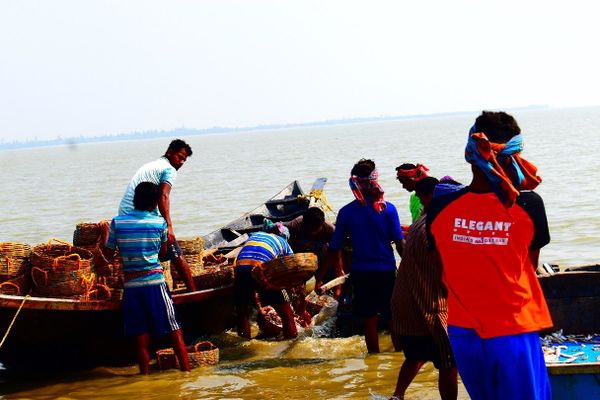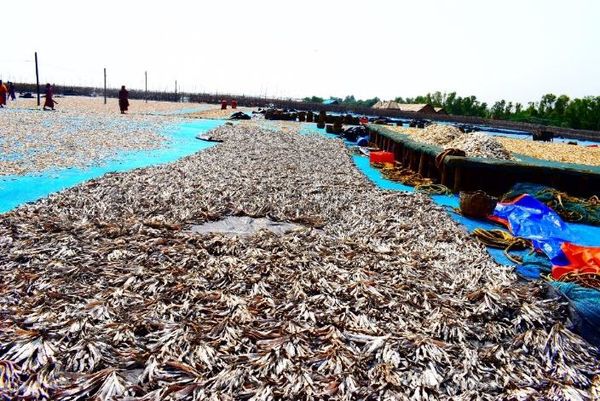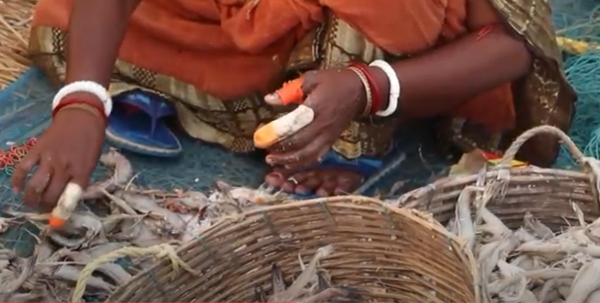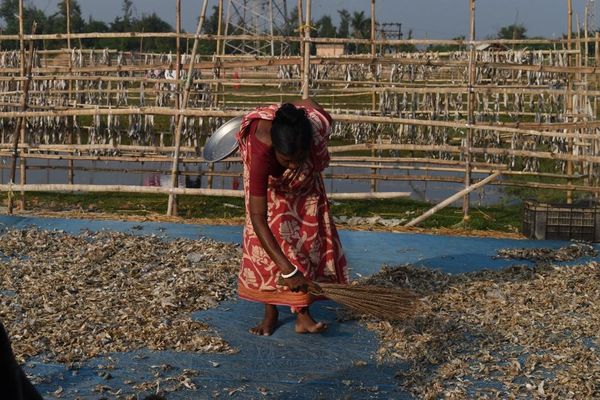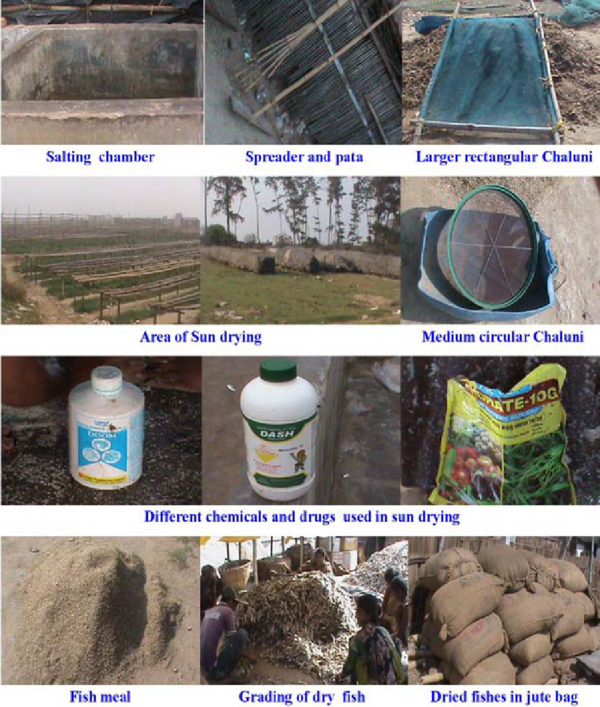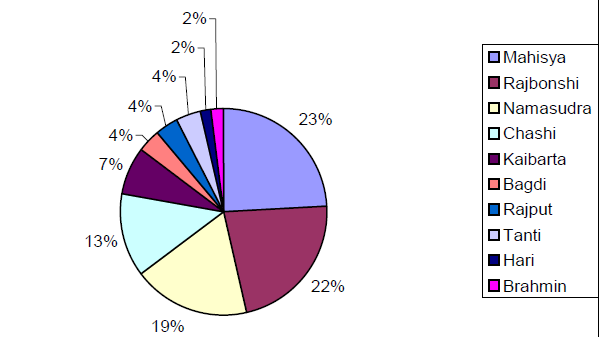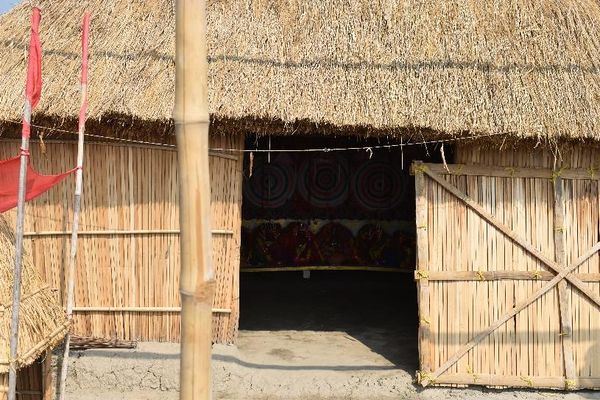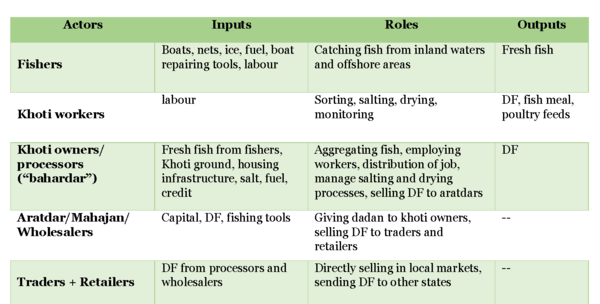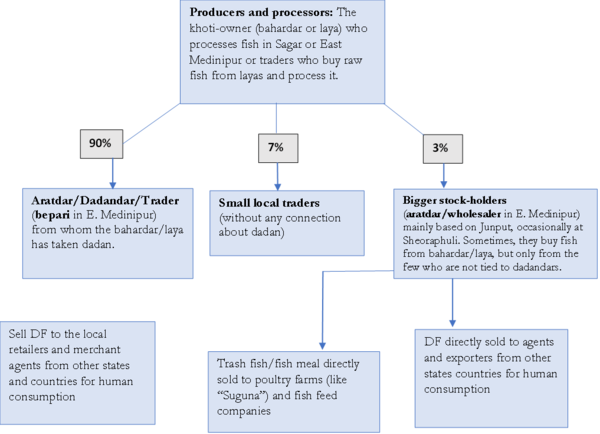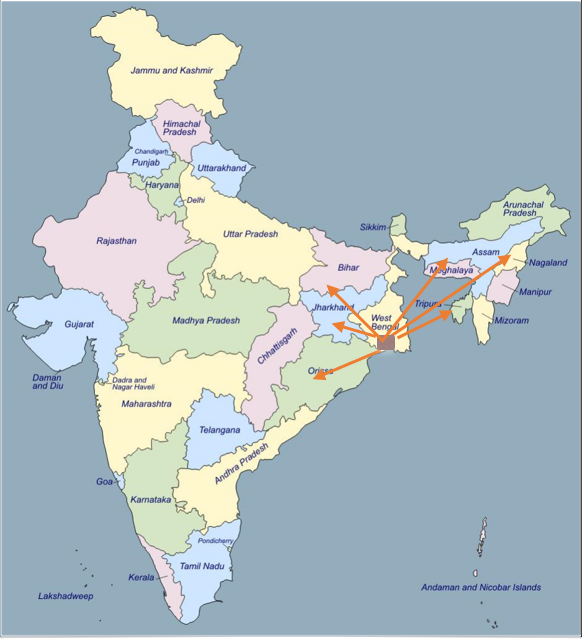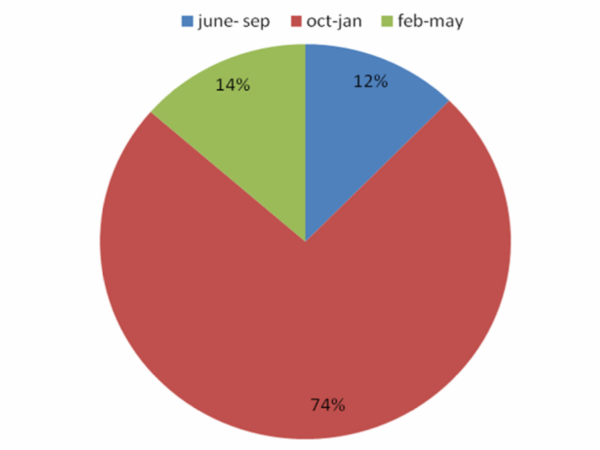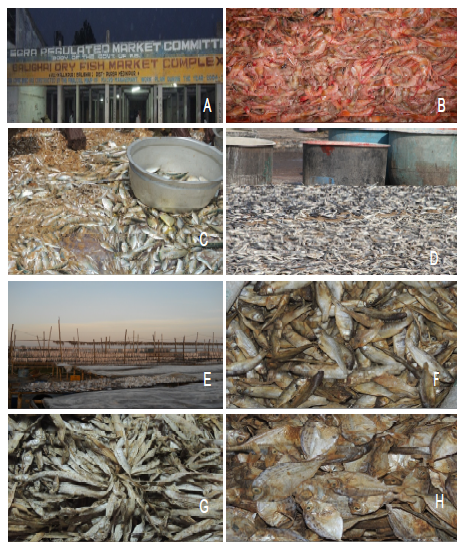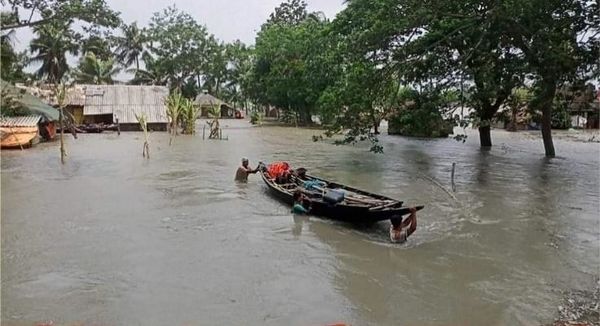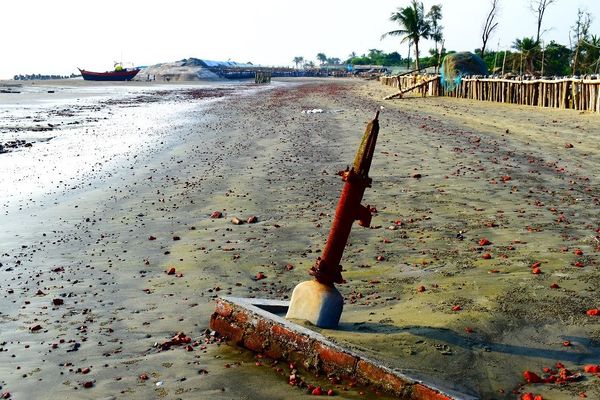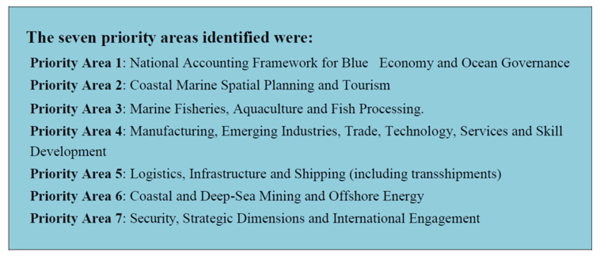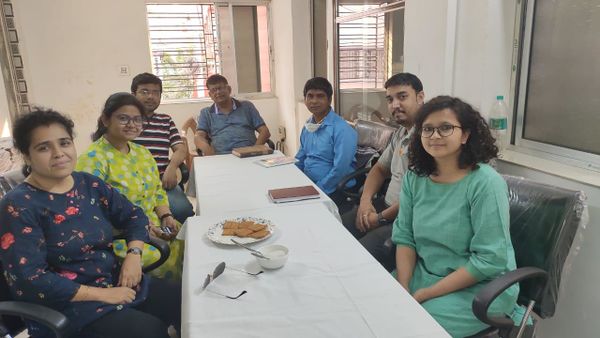Dried Fish in West Bengal, India: Scoping report
Glossary
- Shutki
- Dried fish, in Bengali dialect
- Shabar
- Large, medium and small-scale dried fish camp, owned by local well-off fishers in the Indian Sundarbans. A shabar is where the fish processing activities take place with the involvements of small-scale fishers and labourers.
- Khoti
- Dried fish camp in East Medinipur. Khoti is functionally a counterpart of shabar
- Bohordar
- Dried fish producer and the owner of a large-scale shabar in Indian Sundarbans. A bohordar is generally a fisher who owns a boat, arranges fish drying apparatuses in shabar, employs fishing crew and labourers
- Laya
- Dried fish producer and the owner of a khoti in East Medinipur. Like Bohordar, Laya is the master of his own business
- Moneylender
- A local trader or merchant who holds the dried fish stock. He advances capital to the bohordar or laya on being assured of steady supplies of dried fish
- Bepari/Bebsayi
- Moneylender in East Medinipur
- Aratdar
- Moneylender in the Sundarbans and East Medinipur
- Dadan
- Money that the moneylender advances to the dried fish producer at the beginning of the fishing season. Presuming an amount of dried fish supply, the fund is discharged by the moneylender.
- Hajira
- Daily wage paid to the hired women labourers on ‘no work no pay’ basis in the Sundarbans.
- Fish Meal
- Small dried fishes which are not for human consumption and used as poultry feed
Introduction
Fish drying was adopted as a low-cost, traditional mode of fish preservation in India. Dried and fermented fish contributes substantial micronutrients to the Indian diet and thereby, plays a fundamental role in combating malnutrition and health issues among developing nations of South Asia, such as India (Siddhanth et al. 2020). Over the years, it has evolved from a traditional means of subsistence generation to a full-fledged occupation accruing economic benefits to millions of people (Das et al. 2013). Fish drying is not merely a sector of economy or a robust market conglomeration, but it has a relationship with the geomorphological and ecological components which nourish a wide variety of aquatic ecosystems and resources including fish. Even though a dominant proportion of fresh fish from marine captures and inland aquaculture is iced, consumed and exported within and beyond the country, recent reports (2013-2014) suggest that combined dried fish (DF) export from India measured to 7.86% of all form of fish exports. Notably, India is the second largest fish producing country in the world with the contribution of 5.43% of the total global fish production. West Bengal state with its total inland and marine fish production 16.19 lakh tons and 1.63 lakh tons respectively,[1] ranks second after Andhra Pradesh which produced 36.1 lakh tons of inland fish and 5.64 lakh tons marine fish during 2019-20 (Handbook on Fisheries Statistics 2020).
Fish is an integral part of diet in West Bengal state, located at the eastern fringe of the Indian subcontinent and bordered by the Bay of Bengal at its south. Bengal accommodates the massive Lower Ganga Basin (LGB), crisscrossed by numerous rivers and rivulets, floodplains and the southward active delta stretch which occupies a part of the state’s 158 km long coastline (Centre for Coastal Zone Management and Coastal Shelter Belt, Government of India). The combined riparian and coastal topography of Bengal hosts a great many varieties of fish which in turn, has attracted many people towards offshore and inland fishing activities. The marine or offshore fisheries zone of Bengal has enormous potential for commercial fishes due to influx of nutrient-rich water from the tidal channels and rivers of the two maritime districts- South 24 Parganas and East Medinipur. A sizeable part of marine captures are dried in the fish drying camps along the coastal strip of these two districts. While Bengal is better known for its appreciable inland fish production, the marine sector has grown only since the late 1950s (Bay of Bengal Program 1990). A bulk of the offshore and inshore captures are processed in about 13 dried fish clusters along the coastline of Bengal.
DF value chain as a series of activities involves multiple actors such as fishers, DF workers, owners of fish drying camps, moneylenders, intermediaries, leaders of local government councils, state government agencies and officials etc. That the entire constitution is shaped by the socio-ecological dynamics in a local setting, complicates the notion of “value” in the DF value chain wherein conflicts are common and exposure to risk is inevitable. Understanding DF value chain from the parlance of “social economy” (SE) will be inadequate unless a conceptual cross-fertilization informs about the fundamental tenets of social economy and the ways social, political and ecological factors shape economic relations.
In past few years, scoping study has become increasingly popular on account of its growing potential and rigor to inform research agendas, and policy and practice recommendations by engaging a range of methods and tools (Tricco et al. 2016). It is imperative that scoping research allows an elaborate exercise of mapping a range of evidence in order to convey the breadth and depth of a field. Predominantly an outcome of our pilot field surveys at the Indian Sundarbans and secondary literature review on DF research in Bengal, this scoping report is intended to provide a first explanation of the processes, practices and challenges in DF value chains in Bengal based on our ethnographic observations from the field and triangulation methods. Through expanding on the notion and functioning of social economy in context of India, we capture diverse shades and challenges of the DF sector in the Indian Sundarbans as well as East Medinipur and, thereby, flesh out the scoping trajectories of the DF research in Bengal.
The next section (section 2) weaves the stories of fish and DF from the bygone years and section 3 introduces the landscape, focusing on the two study sites. Section 4 describes the data sources and methodology accessed and applied; section 5 elaborates on the dried fish production units, fish landing centres and the fish production process; section 6 sketches the social contours of communities involved in DF production. While section 7 reflects on the value chain characteristics in the DF Social Economy within our empirical context of application, section 8 highlights DF consumption pattern and nutritional attributes. Section 9 unfurls the narratives of conflicts, risks and vulnerabilities; section 10 brings to the fore the architecture of governance and governmentality. Finally, section 11 provides a brief summary of the scoping exercise.
Historical Overview: Fish in Bengal
Since time immemorial, fish has been conceived as a symbolic entity and received auspicious positions in many religious and ceremonial practices of Bengal. Two medieval-late modern Mangalkavyas including Chandimangal (1594-1606) and Annadamangal (c. 1752), are some of the earlier references of Bengali dishes. Some of the medieval texts even referred to venison meat, tortoise egg, and dried fish which were considered almost sacrilegious to the middle-class Bengalis in the 18th century. Mentions of fish as an intrinsic part of Bengali cuisine, are resonated in the anecdotal accounts of Shriharsha’s Naishadhacharita, Bhavadeva Bhatta’s Prayashcittaprakarana, Chandimangal by Mukundaram, Kalviveka by Jimutvahana and Brihaddharmapurana. In Bengal, the fish production was known from the reign of Pala dynasty (810-850 AD). The use of dry fish can be traced out from the Tikasarbashwa (1159-60) by Sarbanada, who informed that the Bengalis were fond of “Sihuli” or dry fish (Saha 1970). During the mid-19th century, railways as a new means of inland connectivity, started to get impetus in inter-state and intra-state trades which allowed Bengal to bring in fish from different cities of India, especially the port cities like Bombay, Visakhapatnam and Chennai. With the hands of imperial rulers, new fish recipes such as Jewish fried fish and English Rohu fish curry were introduced in Bengal. However, in the book Pak Pranali, Mukhopadhyay had a different opinion about fish curry which he described as: “Europeans learnt to cook “curry” from the Jews and the Jews learnt it from the Muslims. Food became a locus for the construction of the refined middle-class self, something that set them apart from the peasantry and the working classes on the one hand, and the Europeans on the other” (Mukhopadhyay 1883, cited in Ray 2009).
While the northern part of Bengal hosts abundant freshwater fish, the southern catchment area sustains diverse fish species due to the fusion of saline water and freshwater. Both wet fish and dry fish are consumed in different ways by the Bengalis. Popularly known as “shutki”, DF is emblematic to the cultural oneness of (dis)integrated Bengal wherein Bengalis either relished DF with uncompromising endearment or rejected it because of the repugnant odour of a decaying fish. Kolkata-based food historian Pritha Sen reflects that “Each recipe carries the distilled wisdom of experiments carried out through generations- perfect balance of sweet, hot and meaty flavours come together just right”. A mash of dried and fermented fish with easy-to-chew bones, cooked tenderly with garlic, chillies and onion—complemented with rice is a delicacy for the Bengalis. She further added that the cultural estrangement across the river Padma has influenced the eating habits and taboos. In the stack of smells and tastes of shutki, remains the notes of bygone times (https://www.getbengal.com/details/pritha-sen-weaves-stories-through-bengali-dishes).
Bombay duck, a popular “shutki” type in Bengal, is a fish common in the marine waters near Mumbai. The Marani or neap tide period favours the arrival of the fish to the northern side of the Bay of Bengal. Indian-born, British-Parsi writer Farrukh Dhondy, in his book Bombay Duck (1999), explains that the name came from the British mail trains that huffed the rancid odour of dried fish from Bombay to other cities including Calcutta (presently Kolkata). These wagonloads became known as ‘Bombay Dak’, wherein the word ‘dak’ means ‘mail’ in Bengali dialect.
Familiarizing the landscape
Our research spans two coastal districts of West Bengal - South 24 Parganas and East Medinipur. Specifically, it focuses on the western section of the Indian Sundarbans region in South 24 Parganas and the coastal stretch of East Medinipur district:
The Sundarbans
Sundarbans are situated at the southernmost frontiers of the Ganges delta and constitute the largest global archipelago of islands. The islands are interwoven by a host of river channels, before they drain into the Bay of Bengal. Sundarbans is territorially shared between India and Bangladesh. Parts of the archipelago are inhabited and the other parts, nearer to the sea are forested. The Sundarbans Biosphere Reserve (SBR), as Sundarbans is officially known as in India, has assumed a global prominence worldwide due to its wide and exotic range of biodiversity, wildlife and marine resources. The most ‘celebrated’ species is the famous predator of the forest, the Royal Bengal Tiger (Panthera tigris). Sundarbans is the largest remaining tract of the Royal Bengal Tiger, which necessarily occupies an integral core of the terrestrial food-chain and is known globally for its human eating trait. The eminence of the tiger coupled with a range of other wildlife, mangrove species and aquatic resources have acquired the region a status of the ‘reserved forest’ since 1878. This was followed by other landmark provisions of conservation in the aftermath of India’s independence: tiger reserve, national park, wildlife sanctuary, Critical Tiger Habitat and Biosphere Reserve. To mainstream environmental priorities of Sundarbans, international conservation agencies have aligned with the Forest Department of West Bengal to conserve the region. Human settlements in the fringe areas of the forest and their livelihood claims on the forest are considered by the state as the principal threat to the forests.
Sundarbans is the largest mangrove delta in the world. SBR has both inhabited and forested islands. The islands in the delta are interspersed by a maze of rivulets, estuaries and narrow creeks. These islands are inundated twice daily during the high tides and are exposed during ebb tides. The extreme northern limits of SBR have well-knit settlements found in abundance while they also share close proximity with the city of Kolkata. These settlements have a stable land surface since they are away from the forests and the rivers and consequently from the threats of erosion resulting from the intermittent change in the course of the rivers. These settlements are largely dissected by the rivulets and are situated on a relatively unstable land surface. Sundarbans is a fragile and vulnerable ecosystem, prone to intense and incessant real-life threats. In the recent years, the threat has increased due to devastating effects of cyclones. Rise in the sea level accompanied by stronger tidal waves have inundated and eroded away landmass, along with depletion of mangroves. The saline water is gulping on the inhabited lands and forcing people to resign to a future of submergence.
In Sundarbans, the networked roots of mangroves on the clayey substrate, play a crucial role in nutrifying the water, harnessing the food web with invertebrates and acting as nursery grounds for nearly 90% of the important commercial aquatic species of entire eastern coast of India (Chandra & Sagar 2003). Hence, fishing has been the most common and staple livelihood options for the people of Sundarbans (Chacraverti 2014, Bhattacharya 2011). The estimated total number of households in the Sundarbans that have enlisted “fishing” as one of the family occupations is 11% of the households in the area (Sánchez-Triana et al. 2014) whereas this share elevates up to 60-70% in areas with easy access to rivers and forests (Sen and Pattanaik 2017). In comparison to the eastern side of Sundarbans which favours wet fishing in form of traditional small-scale fisheries (SSF), the western part accommodates five (formerly six, including Jambudwip) dried fish (DF) production clusters[2] and twelve DF camps operating at the sea interfaced islands near Hugli River mouth (map 1). Large, medium and mini fish drying camps are nestled in Sagardwip [3] of Sagar CD block [4] and Frasergunj-Bakkhali, Kalistan, Mousuni of Namkhana CD Block. There are three large DF units at Sagardwip namely Gangasagar, Baguakhali and Hatipitiya whereas Baliara, Lalgunj and Lakshmipur are three major DF hubs in Frasergunj village.
East Medinipur
The western coastal strip of the Hugli estuary extends unfettered for almost 50-60 km towards East Medinipur district. The prominent coastal segments of this belt include Digha-Sankarpur, the Pichhabani inlet, Tajpur-Mandarmani, Dadanpatrabar-Junput and Hijili-Khejuri tract. The region is nourished by Khadalgobra and Ramnagar irrigation canals, which jointly discharge water into the Bay at the Digha Mohana point. Geologically, the region is defined by its sub-surface stratigraphic and sedimentary layers on the marine shelf zone which has a prolonged history of upheaval, sedimentary deposition and deformation led by a series of sea-level transgression and regression (Das and Dandapth 2014). The mineral-rich flows of Hugli, Subarnarekha and Rasulpur Rivers fertilize the offshore waters with a wide-variety of aquatic resources including fish. Alongside trawler-based marine fisheries, post-harvest DF production is the most common in several places having wide beach areas. Digha mohana (Digha mouth), Sankarpur, Jaldha, Dadanpatrabar, Mandarmoni, Junput, Jalpai, Gopalpur, Petuaghat and Egra are the major fish landing centres and drying units along this stretch of Bengal (map 1).
Data sources and Methodology
This report is primarily a synthesis of information from various published and unpublished reports, policy documents, journal articles and books (table 1). The academic literature including articles, books and reports were accessed with a focus on key thematics like economy, value chain, ecology, gender, migration, governance and policy. We began with the Zotero library (https://www.zotero.org/groups/2778295/dfm-v2v_west_bengal/library) of the Dried Fish Matters Project (https://driedfishmatters.org/), allowing us to access articles of diverse contexts and findings across India and Southeast Asia. All the articles were then cross-referenced and organized on the basis of Zotero tags which enabled us to map out and catalogue the literatures into different themes and thrust areas. After mapping the literature typologically, it was observed that publications addressing ethnographic characteristics and situational complexities of DF social economy at Bengal, is remarkably scarce. The dearth of academic research accompanied by policy silence on post-harvest fish production, creates knowledge gaps and, simultaneously, prompts us to explore scoping trajectories within the DF production context of Bengal.
Visiting the field as participant observers exposed us to “ground” micro-realities of the Indian Sundarbans. The visits included focus group discussions (FGDs), key informant interviews (KIIs) and informal one-to-one discussions and were conducted at Gosaba block and Frasergunj village during January (2021) and November (2021) respectively. Intensive one-on-one discussions with the fishers and labourers unearthed a host of environmental challenges and socio-political quandaries around small-scale fishing as well as fish drying practices at the Sundarbans region. Our evocative interactions with the stakeholders aided in sensemaking of various symbolic and material relations in the socio-ecological environment which shape and get shaped by diverse ecosystem-based practices in the vulnerable region. Field investigations at the Baliara, Lalgunj and Lakshmipur DF camps of Frasergunj village entailed four FGDs, five KIIs and one-to-one discussions with camp owners, manager, moneylender and labourers.
A confluence of information from different sources was catalysed with the data triangulation method (illustration 1). Our invigorating connections with two Kolkata-based NGOs - Dakshinbanga Matsyajibi Forum (DMF) and Sundarban Jana Sramjibi Mancha (SJSM) resulted in five KIIs which helped us validate former field-based experiences and observations from the reconnaissance survey. We accessed the rare archive of DISHA (Society for Direct Initiative for Social and Health Action) comprising unpublished primary reports and compilations from the field. Thus, trust-building with NGO partners provided us with the grey literature awaiting inclusion in (non)conventional DF research in West Bengal. This scoping report internalizes the complexion of DF social economy in coastal Bengal primarily based on field observations and four reports of DISHA, a voluntary consortium of social activists, environmentalists, public health experts and human rights campaigners operating since 1995. Registered under the West Bengal Societies Registration Act 1961, DISHA has been an active organization at reporting different issues around environmental health and human rights. DISHA’s documentations on DF sector are majorly the results of various projects which were accomplished in collaboration with DMF.
| Major sections in the report | Data source and information |
|---|---|
| Historical overview | Books, articles |
| Familiarizing the landscape | Field reports, articles, books |
| Dried fish production | Books, reports of DISHA, journal articles, field reports, KIIs |
| Social Profile of fishers, workers and processors | Books, field reports, reports of DISHA |
| Value chain insights, economy and trade | Report of DISHA, KIIs, books, articles, government statistical handbooks, field reports |
| Nutritional value and myriad consumptive patterns | Articles, books, KIIs |
| Local conflicts and power asymmetry | Articles, field reports, KIIs, reports of DISHA, field reports |
| Governance | Articles, books, policy documents, KIIs |
Dried fish production
A note on DF value chain and social economy
Fisheries are about relationships between fishers and nature, but also between fishers and others in their human environment: unit managers, fish processors, traders, vendors, government officials, consumers, competing interest groups (Bavinck 1998). In conventional terms, the value chain embodies full range of activities and services that are required at various phases of production, leading to conversion of raw materials into finished food and finally, delivery to the consumers (Jacinto 2004). As such, DF value chain describes the post-harvest span of processing, storage, transport, wholesaling, retailing, food service, and other functions which relate to production and distribution of dried fish for human and non-human consumption. Seemingly, it involves diverse forms of manual labour, managerial expertise and producer services at different segments of the process. As an analytical tool, value chain analysis for economic activities including post-harvest fish production, provides deep understanding about policy implications on resource allocation and benefit sharing within DF organisations and at the same time, makes sense of the response pattern of DF economy to the global economy. In reality, activities within a regional value chain often link to other value chains (such as national and global value chains, and those for other input products and services) and, thereby, complicate the value chain structures with multiple channels and intersectionalities. Scale plays a crucial part in value chains because scaling conditions the structure-conduct-performance triad (Reardon et al. 2012) in terms of linkages, networks, actors, infrastructures and benefit shares.
DF value chain activities take place at the conjunction of three broad domains - community (fishers, producers, labourers, intermediaries, traders, institutions, organizations), landscape (fish, land, aquatic habitat) and governance (policies, legal systems, statecraft). From the systemic schema of reference, the value chain can be regarded as being a repeated cycle of input, throughput and output which broadly operates within three segments – upstream, midstream and downstream (Reardon and Timmer 2012, Reardon et al., 2012). For example, in the upstream segment fishers make use of boats, nets, labour, fuel, ice and credit as inputs, to generate an output i.e. raw fish. The whole range of process, from assembling assets to bringing fish onshore, is conceived as throughput. In the midstream segment, raw fish is used as an input by fish processors who are specialized in translating raw fish into dried fish. After aggregation and packaging, the DF moves to the downstream segment accommodating traders and retailers who finally distribute the DF to the consumers. These segments are tied up with institutional linkages, product and service flows within the economy (Reardon et al. 2012).
In India, DF social economy can be understood as local organizations or associations of communities who are collectively involved in fishing, fish production and trading activities. Legally recognized as cooperatives, the social economy involves democratic decision-making among the participants. By (re-)producing and distributing ecosystem-based goods and services, the organization caters to the sustenance needs of local communities as well as meets the food security of the civil society. National Cooperative Union of India (NCUI) describes cooperative as “an autonomous association of persons united voluntarily to meet their common economic, social, and cultural needs and aspirations through a jointly-owned and democratically-controlled enterprise…Co-operatives are based on the values of self-help, self-responsibility, democracy, equality, equity and solidarity”. In essence, the cooperative registration formally links to training and loan supports from state government as well as national-level institutions such as NCDC, RBI (Reserve Bank of India) and NABARD (National Bank for Agriculture and Rural Development). The social economy layout, thus, is rarely “private-like” or “public-like”, “market” or “state”, rather a complex tangle of all combinations (Ostrom 1990). Nonetheless, under multilateral legal systems and current neoliberal processes in India, it is inevitably penetrable to multiple actors - market and bureaucratic intermediaries, land mafias, provisionary political leaders, state agencies and private organisations – with differential interests and motivation to exercise controls (Smith 2005).
The following section unwraps the formal recognition status of DF socio-economic organizations in Bengal.
Dried Fish camps
In Bengali, a “shabar” or “khoti” is a DF production camp, organized and managed by local fishers in the Sundarbans and East Medinipur coastal strip. Shabar, in the Sundarbans, is the main functional space wherein small-scale fishermen and workers from neighbouring villages assemble and allot their days and nights to fish drying activities (figure 1). In a broader sense, shabar is “democratically” organized fish landing and processing site which, in many instances, corresponds to DF cooperatives in Bengal. It is the site where the interests and involvements of many stakeholders come together, including shabar/khoti owner, fishers, labourers, moneylenders, local wholesalers, fish vendors and local service providers. Different activities are dispersed across spreading, sorting and gathering DF while more experienced fishers, apparently camp owners, earn their fortune from investing capital in the business, more socially vulnerable communities mainly women and children are employed as hired labourers on daily wage basis, popularly known as hajira workers implying “no work no pay”.
The fishery co-operative movement in India began in 1913 when the first fishermen society was organized under the name of “Karla Machimar (Fishermen) Co-operative Society” in Maharashtra whereas Bengal was the next to build cooperative societies in fishery sector in 1918. In Bengal, the fishermen co-operative societies are arranged in three tier system: the apex Federation at State level called Benfish, Central Fishermen Cooperative Societies at District level and Primary Fishermen Cooperative Societies at Village level. Since 1978, the National Cooperative Development Corporation (NCDC, New Delhi, India) started to provide financial aids to the States, aiming at harnessing amenities for fish processing, production, storage and marketing within the regional, apex and primary level cooperative sector of the State’s inland and marine fisheries. (Society for Direct Initiative for Social and Health Action [DISHA] 2016)
During the mid-20th century, the marine fishers’ cooperative of Maharashtra was granted loans from NCDC which facilitated the establishment of cold storage, ice plants, purchase of surface transport vehicles, nets, boats and other equipment. While in Maharashtra and some other states, fishers’ cooperatives were propagated as community-business ventures and sought soft loans to further their business activities, the marine fisheries cooperatives of Bengal sprang up with the sole objective of availing the loan facility.
With anticipation for loans and infrastructural supports, the DF units which were organized as private enterprise at East Medinipur were converted into DF cooperatives in subsequent years. Once informal community associations, the DF centres signalled to function as “well organized” cooperatives having the committee formed with formal electoral process in recognition of the State. Once the loans are disbursed, an official framework for yearly audits are maintained for retaining a position for next loans. Additionally, there are two women’s cooperatives in East Medinipur- at Junput and Dadanpatrabar, which are currently experiencing a setback due to poor leadership and managerial skills (Purkait et al. 2018). In Medinipur, the system of formal elections (to be conducted by the government officials) was introduced in 1998 with a circular from the district-level panchayat body (Jilla Parishad), bringing along an apparently democratic measure to elect the executive managerial body of the khotis.
In Sundarbans, the DF cooperatives proliferated more recently than in East Medinipur, except for a few such as Mahishamari Hatipitia Marine Committee and Matsyajibi Samabay Samiti [5] (survey report of DISHA, Pramanik and Nandi 2006). Assuming financial assistance and other benefits such as banking, transport, storage, marketing and camp infrastructure, most of the shabars which were settled as solidary associations in Sagardwip, transformed themselves into cooperatives, announcing some refined responsibilities and at the same time, called for new hurdles amid the management committee, fishers and DF workers.
The cooperative committee is, thus, a democratically elected board which looks after day-to-day preparations of the landing centre and fish processing activities; resolves contradictions; takes care of the needs and grievances of the members and also, deals with (non)government agencies and villagers. As a formal body, the cooperative is a very different organization than the previous community bodies. Only locally residing fishers can be members of the cooperative. As well, two persons from the same family (generally husband and wife) are not permitted to be members of the same cooperative. Apparently, the cooperative governing board is constituted by only eligible individuals, preferably fishers or those who have some knowledge in fishing. Nonetheless, the formal designation, in part, stimulated business interests into the committee, allowing the appearing of too many peers, intermediaries and market channels in the economy.
DF production practices at Sundarbans
In Sundarbans, the winter season (late October to February) marks fish drying activities in the shabars. Situated at the littoral bed of the Bay of Bengal, the shabar is a bustling space wherein the workers spread, sort and gather DF; more experienced, former fishers weave the behundi jaal (bottom-set bag net); the owner and moneylender of the shabar supervises activities; small children and young girls are in between to help their mothers sort, process and manage routine activities in their temporary huts in the shabar (figure 4 and 5). The DF camps are enlivened with the arrival of fishers and labourers from neighbouring villages of Kakdwip, Pathar Pratima and Namkhana blocks. In Sundarbans, the owners of large shabars have six-cylinder motorized boats, commonly called “bohordar” and fishing activities are usually limited to offshore areas only (Pramanik and Nandi 2004). A six-cylinder “motorized boat” is capable of accommodating a big fishing crew comprising about 3-5 fishermen, 2 boatmen, helpers and 3-5 bottom-set bag nets. Funnel-shaped, tapering bag net, locally called behundi jaal, are used for offshore fishing in the Sundarbans. Capped with a cod end and small-mesh cover at its tip, bag nets capture small sized fishes which are mostly sun dried, except the commercial species including Polynemus paradiseus and Stromateus cinereus (Paul et al. 1997). The bag net is fixed in the tidal stream and attached to the hold-fasts. It is held in a fishing position against the current by linking the extended sides of the net (wing tips) to hold-fasts by means of long bamboo poles and steel wires. The bag net extends 75-150 ft in overall length and has a wide mouth (75-150 ft), short wings (20-25 ft) and fairly long cod-end through which catches are emptied towards the small-mesh size cover. At each slack water period, the net comes to the surface (by means of the bamboo poles, used for opening of the net) when the catch is emptied (Akerman 1986). Again, it is reversed in the opposite direction, ready for fishing, in accord to the strength of the current. and estuarine fishers also use gill nets, locally called sele jaal in the Sundarban region. The fishing crew venture into the sea for deep sea fishing, usually some 40-45 kilometers from the shore. They stay onboard for about 8-10 days. The medium-sized shabars depend upon two-cylinder and six-cylinder motorized boats whereas mini shabars use “bhotbhoti” (one cylinder engine fitted in a country boat) and two-cylinder motorized boats, accommodating small groups of fishers. The small-scale crew often set off for a day and return with fishes like bomla (Bombay Duck), chhuri (Ribbon fish), phansa (Gangetic Anchovy), honey fish (Honey Gourami), shrimps and so on.
Once the fresh catch arrives on shore, the fish is laid out longitudinally over the shabar’s yard which is covered with straw and net. “The layers of straw help to retain warmth for the fish”, they say. Once on the yard, the fish is separated and spread over the net by some 30-35 labourers including men, women, young girls and children. The method of fish drying is traditional and it differs from species to species, depending on size, thickness and oil-content of the fish. Small and thin fishes take 3/4 days to get dehydrated whereas long fleshy fishes such that Ribbon Fish are sundried for 5/7 days until the moisture is completely removed. Throughout these days, the workers are entitled to tend the fish, protect them from dewdrops with the help of nets or polythene sheets, sort the fish into different types and stuff them into gunny bags. During the fishing periods (determined by tides), fishermen often arrive with the capture at midnight when the labourers rush towards the shabar to spread the fish until dawn.
Methods of drying
Fishes are dried by traditional measures in Sundarbans. The big and fleshy fishes viz. kamot, chela, barabhola, datnibhola, medikanta, pomfret etc. are often sliced into pieces superficially and are slightly salted before drying (Pramanik and Nandi 2004). The dissected fishes are then tied with rope by their tails or through gills and jaws for hanging them from specially prepared bamboo poles or racks, in order to provide them with optimum sunlight for dehydration (figure 6). Occasionally, such fleshy varieties are also smeared with turmeric powder before being spread over the yard. Some long fishes like Bombay Duck and Ribbon fish are tied with rubbery threads and hung from thin bamboo poles. Tying the mouths of Bombay Duck (locally called bomla) with 3-4 bomla in a bunch, is a tedious task. In order to protect their fingers from the sharp teeth of bomla, they cocoon their fingers with stretchy balloons (figure 7). Patta, a traditional knife-like tool made of bamboo, is used for sorting and separating fish. Every shabar produces fish meal from the damaged fishes which are of low market price. After drying, the trash fish is sieved with large mesh sized 3.0-4.0 cm and small mesh sized 0.5-2.0 cm traditional sieving tool. The fish meal is directly sold to the fish feed companies and poultry farms like “Suguna”. There are some independent dried fish producers as well as local wholesalers who buy raw fish directly from a shabar owner and dry the fish on the open yard or on the roof of their huts. They usually aim to sell the fish to tourists and local traders. The task is carried out entirely by the members of the family. All the dried fishes are in display at their tiny shop where 1 crate of Ribbon fish, equivalent to almost 1 kg, is sold for Rs. 100/-.
| Class | Species name | Common name/ Local name |
|---|---|---|
| Cartilaginous fishes | Rhinobatos annadalei | Shankar Machh |
| Himantura fluviatilis | Chhata muruli | |
| Bony fishes | Harpadon nehereus | Bombay Duck/Nehari/Loita |
| Trichiurus Lepturus | Ribbon fish | |
| Trichogaster chuna | Honey Gourami | |
| Anguilla bengalensis | Ban/Bam | |
| Hilsa ilisha | Ilish | |
| Ilisha filigera | Phasa | |
| Raconda russeliana | Sada phasa | |
| Anadontostoma chacunda | Khoira | |
| Coilia reynaldi | Ruli | |
| Sillaginopsis panijus | Samudrik bele | |
| Leiognathus blochii | Chanda | |
| Dendrophysa russelli | Bhola | |
| Lepturacanthus savala | Bara chhuri | |
| Cynaglossus bilineatus | Banspata | |
| Crustacea | Macrobrachium lamarrei | Kucho chingri |
| Parapenaeopsis sculptilis | Nona chingri | |
| Acetes indicus | Bhuri chingri | |
| Scylla serrata | Nona Kankra |
Fish drying activities at East Medinipur
Alongside trawler-based marine fisheries, fish production is prominent in several places of East Medinipur. Digha mohana (Digha mouth), Sankarpur, Jaldha, Dadanpatrabar, Mandarmoni, Junput, Jalpai, Gopalpur, Petuaghat and Egra are the major fish landing and drying sites along this stretch. As mentioned earlier, the DF camps are locally called “khoti” and the khoti owners are known as “laya” in East Medinipur. A laborious exercise, fish production is preceded by maintenance and repairing of boats; procurement of suitable nets and other tools; monitoring weather conditions; organizing the crew for navigating into the sea; carrying the dominant catch to the khoti which is overwhelmed by labourers, vendors, traders and local wholesalers (Pramanik and Nandi 2004). India’s one of the leading exporters of DF, the combined DF units of East Medinipur involve over 200,000 people in fishing, sorting, salting and drying, and other services. Amongst them, an overwhelming majority are dependent entirely on fishing (2019 survey report of DISHA). Bottom-set bag net is by far the most common fishing gear used by traditional fishers whereas gill nets are deployed by the troops of more prosperous fishers (around 20% of the total fisher population) during the rainy season (from July to mid-September) for netting the Hilsa shad (Payra et al. 2016). Around 42 khotis continue to function, year after year, along the East Medinipur coastal stretch.
Stages of drying
Traditional sun-drying method is adopted for removing the moisture from fishes. Drying process usually begins after the monsoon retreats i.e. August and continues up to May (illustration 2). At the initial stage, fishes are washed, cleaned and then graded in accord to species, size and quality. Smaller fishes remain mixed with the stock and are sorted out after drying. But important species like Bombay duck, ribbon fish, mackerel etc. are sorted before drying. After grading, fishes are kept in a cemented tank for salting. Usually, 30-35 kg salt is mixed with 100 kg of fish. Salted fishes are left for about 3-4 hours before transferring them into different drying units (Samad et al. 2009). In each khoti, the drying yard is covered by thick layers of straw and nets on which to spread out the fishes. Both sun-drying and salting (curing) are accomplished in the same area. Fishes are turned over at regular intervals to quicken the drying mechanism. Notably, some pesticides and preservatives like Dash, Ostad, Forent-10, EPC-powder, Dursban and Doom are applied for avoiding infestations into fishes (Samanta et al. 2016) (figure 10). Also, fishes are hung in the bamboo poles for fast dehydration. It takes almost 3 to 7 days for complete drying and after that, the dried fishes are stored into the gunny bag, locally called “chat bosta”. Fishes are now ready to be purchased by the “paikers or beparis” (traders) from the khoti owners. Every khoti also produces fish meal from trash fishes like lobster, squid, cuttlefish or from different crabs and raw fishes which are of low market price.
Social profile of fishers, workers and processors
A shabar is organized for their own use by people who reside in neighbouring villages and convene during the winter. Most importantly, they belong to disparate caste, class, gender, religion, personal and ancestral backgrounds determining the pattern of their involvements in the shabar and defining their social, economic and cultural identities in the mundane world. For example, the small-scale fishers of a shabar generally belong to Jele Kalibrata, Paundra and Rajbanshi (Jele) fishing castes, whereas most of the labourers belong to both fishing and non-fishing castes such as Pod, Tiyar, Maal, Munda, Bedia, Bagdi and Turi. A shabar owner is also a fisher by caste, having the ecological, technical and cosmological knowledge for fishing alike the small-scale fishers who travel long distances for deep water fishing. But, a thin line has been drawn here by the economy-based class relation between the well-off shabar owner and the employed fishers. On other hand, the landless DF labourers have learned sorting and fish drying techniques through interaction, experiences and continued practices with their fellow workers and family members who have been involved in this practice for long. Rest of the year, the DF workers catch tiger-prawn, locally called “Meendhara”, in the murky water of the delta.
“I know about fishes and fish drying techniques from my mother who used to work in the shabar”, said Milani Das, a DF worker from Baliara shabar.
The bohordars as well as the retired and old fishermen predominantly belong to fishing castes such as Jele Kaibarta (80%) and Rajbanshi (20%). Rest of the working groups including hired labourers and casual workers, managers and accountants of the khotis are affiliated to non-fishing scheduled castes (SCs). Also, a few of them belong to higher castes, such as Mahishya.
To all appearances, the members of khoti fishermen and worker community are those who, a) catch fish, b) are fishers by caste, c) are fishers by occupation, d) are members of a fisher family, e) are fish sellers, f) are fish sorters or driers, g) are members of the khoti and h) live in fishers’ villages (survey report of DISHA). In all khotis, Bengali Hindu and Muslims make up the dominant religious composition whereas Santhal people constitute the rest. Moreover, Rajbanshi (both Jele and Bagdi) and Chashi Kalibrata (traditional cultivators) castes form the majority in all the khotis (figure 6). Field investigations (2016 and 2019) of DISHA explain that people who traditionally pursued fishing are commonly included within fishermen community, whereas some are of the opinion that occupation, instead of caste, is a relevant determinant to whether a person is a fisher. However, most of the fishermen come with their whole family and stay for roughly six months until the fishing season is over.
Beliefs
An extensive area situated on the eastern bank of Rasulpur River in the Contai subdivision of East Medinipur, Hijli has a rich 300-year-old history, associated with Dargah of Masnad-e-Aala or Hijli Sharif Mazar. The history of Hijli Sharif spans from 15th to 18th century. The Sharif is the pilgrim site for the fishers of East Medinipur and Sundarbans. They believe that Babasaheb will protect them from natural calamities. In the shabars of Sagardwip, Frasergunj and Kakdwip in Sundarbans, river Ganga, lifeline of the fishes, is worshipped as Goddess during February-March.
Gender renderings
In Sundarbans, women workers labour for 8-10 hours a day which earn them a paltry daily wage revolving between Rs. 150/- and 250/-. Often the wages are paid in kind- one ferki (basket made of bamboo sticks) with 20kg of trash fish, offered as payment (Pramanik and Nandi 2004). Moreover, they are contracted to hajira works with “no work no pay” basis and receives no additional payment for labouring overtime. More often than not, their working hours exceed 12 hours with one or two hours of interlude for breakfast and lunch. Rigorous monitoring of fish under the scorching summer heat, however, is not easy for the women who also have their day-to-day roles to play in the households (figure 13). Alongside the tedious job, they encounter a living in abysmally small and frail huts of shabar accompanied by lack of electricity and poor sanitary amenities. However, large shabars obtain electricity from generator, installed by the owner. A large number of young girls and children below 18 years of age are also committed to help their mothers in fish sorting, spreading and storing activities. Those who belong to the distant villages are often compelled to leave their children with other members of the family whereas sometimes, mothers are accompanied by the children in their activities at the shabar, offering instances of child labour.
Value chain insights, economy and trade
Speculation of future catches against monetary advance is the most common feature of the fishing economy in both Sundarbans and East Medinipur.
In Sundarbans, the bohordar or shabar owner is a fisher (either by caste or occupation) or a person having knowledge of fishing, as discussed earlier. He generally owns a boat, employs fishing crew and workers after taking land on lease to conduct entire fishing and fish drying operations. The aratdar or wholesaler, is a merchant who usually holds both raw fish and DF stock. He advances some funds to the bohordar at the beginning of fishing season to secure the right to the catch. This monetary advance is locally called “dadan”. The aratdars, thus, act both as moneylenders and traders who sell the fish to other traders. Shabar owners (bohordar, also known as “laya” in East Medinipur) of Sundarbans are, thus, bound to sell the DF to the moneylenders as they receive dadan for their next steady supplies of DF, albeit a better bargain or price could be achieved elsewhere (table 3). The moneylender is usually more concerned with being assured of fish supply at a reduced price. The moneylender’s economy is all about buying fish (either raw or dried) at as low a price as possible so that he can make a higher profit when he sells the fish to small traders, retailers and big stock-holders. If the bohordar fails to repay his dadan, it is transferred to the next season, when it is added to the current dadan and contributes to pulling down the price that the bohordar receives for the catch. This benefits the moneylender. The moneylender is ever-ready with his advance and even advances money for the personal contingencies and needs of the fishers.
While the major amount of the catch moves to moneylender, rest of the catch is sold to small, local traders (without any loan or dadan) and occasionally, to the stock-holders who would buy DF from the bohordar, but only from the few ones who are not tied to moneylenders and are free to sell their products to whomever they prefer. Dominant fish auctioning centres around the Sundarbans’s shabar areas are Namkhana, Kakdwip and Diamond Harbour which are channelled to the wholesaling and retail markets of Kolkata (Territy Bazar), Howrah (Uluberia, Phuleshwar), Hugli (Sheoraphuli) and even East Medinipur (Egra and Contai) (illustration 3).
East Medinipur, however, draws an elaborate frame of market network and DF trade routes. In the outset of khoti season in October, the laya (khoti owner) seeks capital for arranging the campsite – preparing boats and nets, form the fishing crew and perhaps pay advance to some of them, storing usual supplies, meet expenses necessary for fish drying on the beach, and so on. Alike Sundarbans, the whole or bulk of the capital (and sometimes domestic loans) is received as an advance or dadan from a trader, locally known as “bepari” or “bebsayi”. However, this advance often does not flow as a single package as the laya might need more money during the course of the season which simply add up to make the total dadan. The market thread is sequentially constituted by layas, aratdars/beparis/wholesalers, small traders, retailers and consumers. Aratdars or wholesalers are stock-holders who buy both raw fish and DF from layas for wholesaling to retailers and exporters. Small traders buy a small amount of DF directly from layas without dadan or advance money. Men, women, and child workers engage in the processing activities of spreading, sorting, and monitoring the fishes during the whole drying process. Often the workers are sourced from the families of fishermen or crew members (Payra et al. 2016). Beparis are relatively professional traders who buy DF from fish processors or layas, and generally sell it to the wholesalers as well as retailers. However, retailers also buy DF directly from the aratdars or wholesalers. After the DF reaches retailers, it is sent for both national and international exports. In West Bengal, Egra market at East Medinipur is the largest regulated DF market which trades fish from the Sundarbans as well as Medinipur.
Market and trade dynamics
Egra
Egra dry fish market at East Medinipur is the largest DF market of West Bengal. DF from almost all processing areas such as, Digha mohana, Sankarpur, Jaldha, Junput of East Medinipur, Sagar Island, Bakkhali, Frasergunj of Sundarbans as well as Odisha, are usually forwarded to this market for exporting to different states in India (figure 9). A large number of wholesalers and retailers operate here. It is estimated that around 14,000 to 18,000 tonnes of DF move through Egra every year (Ghorai et al. 2014). The market becomes active during the winter season (October to January) as the supply remains most consistent during this season. The price of different dried marine fish depends upon the size, availability, quality of the species, transport, labor and season. The best quality of the DF product, suitable for human consumption, is graded for export, whereas low quality damaged and putrefied dry fish containing sand are generally graded for use in the fish meal industry for making poultry/fish feed.
According to the Food and Agriculture Organization (FAO) fish output in India doubled between 1990 and 2010 (FAO 2011). Recent report (2013-2014) also reveals that India is the second largest fish producing country in the world. As per the 2014 report of FAO, per capita fish consumption (per annum) in different countries are- Japan – 62 kg, China- 35.1 kg, Sri Lanka- 28 kg, Bangladesh- 27 kg, India- 6 kg and within India Lakshadweep ranked first followed by the Goa, Kerala and West Bengal (Payra et al. 2016). During 2010-11, the volume of fish and fishery products exported from India was 8,13,091 tonnes worth 12,901.47 crores and during 2011-12 export earnings crossed USD 3.5 billion. Export aggregated to 8, 62,021 tonnes in volume with a value of 16,597.23 crores (2012-13 report of Department of Animal Husbandry, Dairying & Fisheries, Govt. of India). West Bengal occupied the first position in the State-wise fish production in India during 2010–2011; the total fish production (marine and inland) of West Bengal was 1,615,313 metric tonnes (Ministry of Agriculture, Government of India 2012). In West Bengal, about 78% of total fish catch is consumed in fresh condition, 6% is used as dry fish and the rest is used as frozen fish. As per the National Statistical Handbook (2008), Bengal produced 1,11,517 tonnes of preserved and processed fish products. Combined DF export from India measured 7.86% of all forms of fish exports and it earned 819 crores during 2013-2014 (Sahu et al. 2018). The DF from Bengal is shipped to the states like Assam, Bihar, Uttar Pradesh, Odisha, Tripura, Manipur and North-Eastern states (figures 14 & 15). It is also exported to foreign countries namely Bangladesh, Myanmar, Nepal, China, Thailand, Indonesia. As such, 51% of the fish curers undertake export of DF mostly to Bangladesh through middlemen or traders and fetch good returns.
Nutritional value and myriad consumption patterns
In general, fish muscles contain body water between 70-80%, protein 13-22%, mineral matter 1-3.5%, and fat 0.5-20% (Saha and Chowdhury 1951). Several contemporary studies have pointed to the nutritional standards of DF which is predominantly a source of low-cost dietary animal protein. Most importantly, wet fish are heavier than dried fish but nutrition is more concentrated in dried fish (Majumdar 2006). DF is considered as a healthy diet as it is primarily a natural product, enriched in micronutrients, omega-3 fatty acid which is good for neonatal brain development and antioxidant properties. One hundred grams of dried fish contain around 80% protein with 300 calories against animal meat that constitutes double the calories and far less protein. Studies of Gopalan et al. (2004) suggest that 100 grams of dried Ribbon fish contain 383 Kcals energy, 76 grams of Protein, 739 mg of Calcium, 700 mg of Phosphorous and 4 mg of Iron. DF also contain little cholesterol and saturated fat, and thus, don’t raise blood pressure and aggravate heart issues as red meat, in particular, does. People often find DF reasonable to include in their food menu in order to ward off heart illnesses, diabetes as well as obesity (Sajeev et al. 2020). DF with a pH measure in the range of 6.0-6.9 indicates very good quality. However, pH value elevates with time due to increase in basic compounds within the fish.
Bengal’s shutki cuisine has a versatile take as Bengalis prefer adding leafy green vegetables including brinjal and pumpkin with shutki whereas in Maharashtrian cuisine (western coastal belt of India), Bombay Duck is rehydrated and softened by soaking it for half an hour before preparing curry (Ray 2009). DF is often regarded as a substitute for fresh fish as it is available throughout the year and can be stored longer without preservation. In reality, consumers are willing to pay for hygienically prepared fish with desired physicality. Moreover, the consumers of Bengal prefer unsalted dried fish unlike the consumers of Bangladesh (KII with Narayan Das, a DMF representative). Varying olfactory cues and cooking traditions across different corners of the country, influence its demand and market values in India.
DF preparation styles and consumption behaviour often are the outcome of varying sociocultural “situatedness”, attributed by adherence to traditional way of living and knowledge systems, shared values and norms, remoteness from the market places, affordability, exposure or experiences to different food cultures and food habits etc. Tribal people of hilly regions prepare DF powder which are reserved for consumption during fish scarcity whereas most people living in urban areas make different kinds of curries and fries along with vegetables and spices. Additionally, coastal inhabitants consume DF simply with rice, alongside using it as poultry and fish feed.
Local conflicts and power asymmetries
Tenurial rights
In India, common property resource (CPR) refers to all such resources which are accessible to the whole community without exclusive property rights, rather the practices determining the access to these resources are generally conventional. In this light, CPRs in India account for village pastures and grazing grounds, village forests and woodlots, protected and unclassed government forests, waste lands, common threshing grounds, watershed drainage, ponds and tanks, rivers, rivulets, water reservoirs, canals and irrigation channels. The shabars of Sundarbans are not excluded from formal and informal regulations on the use of coastal lands for setting DF camps. Most conspicuous of all forms of discontent, is the tenancy rights or land tenure rights which have always been valorised by the DF units for their extensive use of space. Contestations associated with space for shabars along the beach areas, are acute in Kalistan, Frasergunj and Bakkhali. Tenancy rights are only acquired by bohordars after occupying the plot for successive years without any temporary termination. The bohordars of three shabars of Sagar Island (Gangasagar, Baguakhali and Hatipitia) have formed associations for protection of the tenancy rights. Interestingly, tenancy rights cannot be transferred or sold, it can only be inherited by the legal heir of the occupant, subject to the approval of the association. While most of the shabars of Sagardwip have been converted into cooperatives, shabars of Frasergunj have been unable to access the benefits as a formal cooperative system because the shabars are situated on the “land of the government” (KII with the owner of a large shabar in Lalgunj). “To be granted a legal recognition like cooperative, the shabar must be settled in the private land of the owner. I only have two bighas [6] of land in my village at Kakdwip”, says the bohordar of Lalgunj shabar.
Imminent ecological challenges
The DF social economy encompassing the offshore fish production, is rooted in the copious pool of natural resource that is fish. But fish diversity is currently under grave endangerment emerging from the rise in sea-water temperature, land erosion by elevating sea levels, downstream freshwater scarcity, siltation etc. As an active delta, numerous islands are still in the process of formation-submergence-reformation with persistent silt accretion and erosion from powerful tidal currents (Nishat 2019, Nandy and Bandyopadhyay 2008). But the tidal hydraulics in combination with rising water, is claiming land areas of sea-facing islands, especially Sagardwip, Mousuni, Frasergunj and Jamudwip (Bandyopadhyay 1997, Hazra et al. 2002). A broad range of research makes evident that the climate change consequences are dominantly playing into alteration of marine, riverine as well as estuarine habitats, resulting in decline of fish stocks, species variety and fish obtainability (Auerbach et al. 2015, Hazra et al. 2002, Nishat 2019, Chand et al. 2012). Additionally, salinity level at the estuarine section of the Hugli river and its dominant tributaries have been swelled due to substantial reduction in freshwater supply from upstream (Rogers and Overeem 2017). Installation of large dams including Farakka Barrage at the upstream section led to massive siltation in the Bhagirathi-Hugli River. The coupled pollution, siltation and changing salinity gradients has disrupted the habitat of several fish species dropping off fish diversity and fish stock in the region (Das 2009, Danda et al. 2011). In their 2015 survey at the Sagardwip and Basanti block of the Sundarbans, Dubey and co-authors (2015) recorded the reflections of the fishermen mentioning about the declining stock of Dwarf Snakehead, Gangetic Leaffish and Mola Carplet roughly since last 30 years.
Of all the natural hazards, cyclones are the most severe and routine occurrences in the Bay of Bengal coast. Since the beginning of 21st century, the northern Bay of Bengal has witnessed five cyclones- Sidr, Nargis, Bijli, Bulbul, Aila and Amphan, which led to powerful storm surges resulting in embankment breaches and saline water intrusion at the islands. The monstrous coastal floods ravage campsite infrastructures including boats, gears, and frail huts. Moreover, powerful cyclonic surges when accompanied by Spring tidal waves, generate massive waves which breach the earthen embankments to devour land, livelihoods and livestock, and leaves life afloat on water for a few days. The deep-water exercise is a familiar claimant of fishers’ lives as the boats are often overturned by huge tidal waves, empowered by sudden storms and winds. Notwithstanding the challenges of dwindling fish stocks and storms, they remain more focused at capturing ample fish that is the pivotal resource base for their living. Furthermore, shabar committee and DF workers are elusively concerned about the erratic winter rainfall, as evidenced by the latest cyclone Jawad (4th December, 2021), leading to inundation of the shabar yard and spoilage of fishes. While shabar owners are nettled with diminishing fish stocks, vicious showers and sudden outbursts of cyclones acting upon their speculative supplies of fish, DF workers are stirred by attendant downturn of wages, inimical living conditions at the shabar, poor connectivity between their villages and shabar and so on. “Crossing a creek every day at the North of Lalgunj to reach the shabar, is a difficult job as there is no connecting bridge”, they say. The two paramount DF clusters in Sundarbans - Sagardwip and Frasergunj, was hard hit by the cyclonic surges as there is no mangrove frontier to defend the islands from cyclonic surges (figure 18 and 19). Hence, the islands are eroded at a faster pace leading to shrinkage of land. In the midst of Covid-19 pandemic, the very severe cyclonic storm Yaas (26th May, 2021) brought devastating impacts upon the DF clusters of Medinipur coastal area as well as the south-western Sundarbans.
Environmental implications are further magnified by upstream felling of mangroves for land clearance, oil contamination in coastal waters from trawlers and tourist boats, destruction of zooplankton by trawler-based commercial fishing and so on. The giant mechanised trawlers with 120 horsepower engines, drag large trawl nets through ocean-bottom to chase tiger prawns, resulting in destruction of bottom habitat of prawn, shell fishes, marine algae, seaweeds and plankton (Das 2009). The aquatic habitat is further tainted by floating microplastics, outflow of toxic wastewater from commercial shrimp monoculture ponds coupled with non-point pollution from river-side industrial centres. Seemingly, natural and human-driven stressors are cumulatively acting upon the aquatic habitat. While scientific scholarship is immersed at capturing the ramifications of overfishing to the coastal or estuarine and advocating for the restoration of maritime resources (Pauly et al. 2002), the stories of fishers and fish producers have remained unheard.
The nature of vulnerabilities of the people who share a common work space in a dynamic ecological zone, is defined by their socioeconomic position which in turn, conditions their short-term coping tactics and continued adaptation practices. For example, shabar owners are vulnerable to reduced fish catch that impels them to sell dried fish at a low price to the moneylenders; cyclonic surges often disrupt shabar infrastructure which they need to rebuild again without any compensation; unwelcome winter rainfall spoils the DF stock leading to substantial declines in price. Given the same sources of risks, the vulnerabilities of DF workers and fishers reflect their livelihood practices and living conditions. A decrease in catch size that influences the profits of the owner, leads to wage fluctuations for the foundational stratum of the value chain composed of fishers, DF labourers and other workers. Moreover, cyclonic surges uproot them from their huts which are made up of bamboo poles and tarpaulins and drowns their livestock.
DF labourers rebuild their huts after each cyclone and endure the foul odour of rotten dried fish after the winter rainfall. The short-term coping tactics which add to their collective adaptation mechanism, anticipate support and assistance from those who are in administration. During the survey, many of the workers mentioned that they did not receive any compensation and post-disaster relief kits and further, commented on the unequal distribution of Government relief kits in the area. Women labourers who come from distant villages, pointed to alternative livelihood options that include weaving and gardening which, they assume, might earn them a good living.
In-house uncertainties
The fish drying space supports diverse relations among dried fish actors. Commonly, moneylenders share an amicable relationship with the shabar proprietor who has promised to sell the fish to the moneylender, although this easy-going connection is borne out of business negotiation between them. But sometimes, a horizon of discontentment appears if the promises are not met. There are some intermediary brokers who create contacts between shabar owners and dry fish workers on the basis of some commissions. All these communications and exchanges usually take place within local, neighbourhood circle and thereby, negotiation is common among shabar owner, moneylender and other business intermediaries. But dried fish labourers do not have a say about their wages and basic services in the shabar as they hardly have any alternative choice of work available. From fish capture to dried fish trade, any change at one level can generate positive or negative ramifications in other segments of the value chain.
As the laya (Medinipur) or bohordar (Sundarbans) forever remain indebted to the moneylender and are rarely able to meet the target for optimum profits. Sometimes, the camp operations are impaired by lack of capital coupled with the inaccessibility of low-interest rate institutional loans. Under these circumstances, owners are bound to either get hold of private credit, money advance from traders or seek government loans. Dependency on informal credit diminishes their profits and keeps them trapped within the vicious cycle of capital deficiency. Selling the entire fresh or dried fish to a moneylender, takes away the control over the catch and thus blocks the possibility of taking advantage of other value-addition options. Even though government’s intervention towards allocating easy loans and subsidies, providing market exposure training as well as technological training, may ameliorate this muddle to an extent, such opportunities are extremely inadequate so far as Bengal’s DF sector is concerned. Added to this, drastic changes in fish availability, fish size, diversity and abundance is shaping the social and economic vulnerability of the fishers and labourers. Often the fish supply has not kept up with the steady rise in demand leading to a steep hike in prices for the consumers and slender profits to the fish production team.
An interesting survey (2016) of DISHA unravels fisher’s perceptions on advance money (dadan) and price fluctuations. They mentioned about the following problems of indirect sale or sale through intermediary traders (figure 20):
Governance
West Bengal has a prolonged history of local self-government institutions as a product of the Local Self-Government Act of 1885 and the Village Self-Government Act of 1919. These were created by district boards and union committees on the basis of limited electoral franchise, and were dominated by the landowner class. With the democratisation of the Panchayati system (post 1977), the then government sought to introduce a new social and economic order aiming to liberate individuals. This trend has been reinforced by political favouritism which revitalized disparate, unequal class relations. Even though small-scale fisheries contribute significantly to the state-level economy, they have received little attention in terms of decentralised planning and loan support in comparison to large-scale commercial fisheries. Here lies the indelible role of state and national-level policies which reinforce and get reinforced by existing socio-economic inequities.
All rights reserved
An array of legal scripts, pertinent to the context of coastal fisheries of India and Bengal:
| Year | Name of Act/ Rule | Level |
|---|---|---|
| 1897 | The Indian Fisheries Act | National |
| 1927 | Indian Forests Act | National |
| 1972 | The Wildlife Protection Act | National |
| 1972 | The Marine Products Export Development Authority Act | |
| 1974 | Water (Prevention and Control of Pollution) Act | National |
| 1976 | The Territorial Waters, Continental Shelf, Exclusive Economic Zone and Other Maritime Zones Act | National |
| 1978 | The Coastal Guard Act | National |
| 1980 | Forest Conservation Act | National |
| 1981 | The Maritime Zones of India (Regulation of Fishing by Foreign Vessels) Act | National |
| 1982 | The Maritime Zones of India (Regulation of Fishing by Foreign Vessels) Rules | National |
| 1986 | The Environment (Protection) Act | National |
| 1991 | The Coastal Regulation Zone Notification | National |
| 1993 | West Bengal Marine Fishing Regulation Act | State |
| 1995 | West Bengal Marine Fishing Regulation Rule | State |
| 1998 | West Bengal Marine Fishing Regulation (Amendment) Rules | State |
| 2001 | The Trade Unions (Amendment) Act | National |
| 2002 | The Offshore Mineral (Development and Regulation) Act | National |
| 2002 | Biological Diversity Act | National |
| 2003 | Water (Prevention and Control of Pollution) Cess (Amendment) Act | National |
| 2005 | The Disaster Management Bill | National |
| 2006 | Coastal Aquaculture Authority Act | National |
| 2006 | The Scheduled Tribes and Other Traditional Forest Dwellers (Recognition of Forest Rights) Act | National |
| 2007 | The Inland Vessels Amendment Act | National |
| 2010 | Wetlands (Conservation and Management) Rules | National |
A crucial part of state-level legislation is The West Bengal Marine Fishing Regulation Act (1993) which conditions that fishing vessels shall obtain both a licence and registration in order to carry out fishing operations. According to section 14, the State government may, by notification, declare any harbour as a fishing harbour and any centre as a fish landing centre, and thereupon, retain the management interventions and control over such areas. However, the Act does not utter a word in recognition of existing fish landing centres that are being managed by autonomous organizations. Moreover, section 4 (2, b) reflects that the government shall have regard to “the need to conserve fish and to regulate fishing on a scientific basis” and 4 (2, a) asserts “the need to protect the interests of different sections of persons engaged in fishing, particularly those using fishing vessels such as catamaran, country craft or canoe”.
Noise and silence at the national policy circle
After independence (post 1947), India’s economy sought a planned economic intervention by the newly formed government. Along with the formation of the Planning Commission in the 1950, the first Five-Year plan was launched as a centralized and integrated national economic program in the year 1951. Formulation and implementation of plans within different sectors of the economy witnessed substantial up-and-down throughout past years until the latest 12th Five-Year plan (2007-2012).
The successive Five-Year plans of India demonstrate how the policy makers and planners visualize the fisheries sector, with major focuses surrounding enhancement of production and productivity of the fisheries and aquaculture sector, augmentation of marine, brackish and freshwater fin and shell-fishes as well as other aquatic species, increase in per capita consumption of fish, improvement in socio-economic conditions of the fishers, conservation of aquatic resources and genetic diversity (Bapat and Kurian 1981). Towards the latest plan periods, attention has been anchored on mechanisation, trade and export-centricism as a basis for policy formulation. The plans and policies posed greater weight to the mechanised marine fisheries sector than small-scale fisheries and DF production sectors that are functional in different localised pockets of India. More specifically, the DF sector has received almost no mention in the policy so far, except for a few words on fish preparation techniques and quality enhancement of post-harvest fish products. Even though, many financial institutions like Industrial Finance Corporation of India (IFCI), Industrial Development Bank of India (IDBI), Shipping Credit and Investment Company of India (SCICI), State Finance Corporations (SFCs) and National Co-operative Development Corporation (NCDC) propagated during the 1980s in order to lend credit for brackish water aqua boom. Nonetheless, the credit disbursements and number of sanctioned schemes witnessed sharp downward turns since the 1996s. Like agriculture, social justice and distribution issues have not been at the forefront in planning discussions with regard to capture fisheries in India (Byres 1998). In reality, fisheries development planning bore little concern until very recently when fish stocks have shown increasing signs of stress (Bavinck 2005).
A recent policy publication on the Blue Economy framework by the government of India (India’s Blue Economy, September 2020), has offered a clear glimpse of future policy orientations, motivation and mode of government (non)intervention towards small-scale scale fisheries and DF sectors. The revealing “content” section of the Blue Economy policy brief points out priority spheres of spatial planning in ocean governance, tourism, emerging industries, coastal and deep-sea mining and energy, strategic dimensions and international engagements etc (figure 21). Notably, there have already been strong protests in India against foreign equity participation in deep sea fishing and the government had to rescind its commercial Deep Sea Fishing Policy in March 1997. Moreover, there has hitherto been a protest by the traditional fishers of southern India against the decision by the Union government to permit foreign trawlers to operate in Indian waters. The seven-member team was appointed soon after Prime Minister Narendra Modi made an appeal for a “Blue Revolution” at the Foundation Day address in Indian Council for Agricultural Research last July (2020). According to the fishermen, following the submission of the report by the panel, the Union Government recently issued a notification inviting proposals from multinational companies. In opposition to this invisible back-end approach, fishermen and women raised slogans against the Union government and burnt the copies of the committee’s report.
In order to accelerate the “development” of the fisheries sector, Indian government has published the draft National Fisheries Policy 2020 (NFP), which aims to encapsulate all components of the fisheries sector into a single document and create an environ for increasing investment, double exports, and incomes of fishermen. In response to this long overdue draft policy brief, National Platform for Small Scale Fish Workers (NPSSFW), has noted that the Department of Fisheries (Government of India) has taken no effort to facilitate stakeholders’ consultation on the draft NFP. The draft report proposes to place fishers and fish-farmers at the core of the policy, but there has been a gap in carrying forward the objectives as well as dealing with the matters of sustainability, inequity and conflicts within the fisheries sectors. One of their published report that comments on the NFP, asserts that “by continuing to place the fisheries sector under the umbrella of the Blue Economy framework, the policy is unable to do justice to its commitment to stem the ecological decline….natural resources related to fisheries are common property assets protected by the Public Trust Doctrine (Article 21, Constitution of India)”. The Blue Economy framework is not conducive to the notion of achieving minimum adverse impacts on environment or fisheries as it is evident from the impacts of Sagarmala, shipping corridors, waterways undertakings etc. The policy script fails to demonstrate the central role of the small-scale fishermen and workers as one of the largest groups of primary stakeholders and natural custodians of the waterscape of India. Moreover, there is no mention about the livelihood security and wellbeing of women fish workers in the NFP despite their unparalleled contribution to the whole fish farming sector. NPSSFW further holds that the Draft NFP 2020 should not “aim at” but be “based on” overarching principles that would provide guidance and preclude divergence from those, not only for its present policy proposals but also in dealing with policy requirements in future and thereby proposes to consider “seven pillars, namely sustainable development, socio-economic upliftment of fish workers, principle of subsidiarity, partnership, inter-generational equity, gender justice and precautionary approach with the aim for fostering inclusive development, promoting self-reliance and entrepreneurship and charting a road-map for the fisheries sector for the coming one decade”. However, under the head TIUSMP” (Technology and Infrastructural Upgradation Scheme for Marine Products), MPEDA has asserted that an assistance of488.57 Lakh was disbursed to 11 beneficiaries belonging to the various categories like the Seafood Processors, Exporters, Chilled and Dried Fish Exporters, Pre- Processing plants, Processing plants etc., during 2019-20
Through the lens of state-level policies
In India, States play a pivotal part in fisheries governance with partial, yet influential interventions from the Central government. The Central Government complements the States’ efforts under the guiding principles of cooperative federalism. Two key features of cooperative federalism are- (a) a joint focus on the National Development Agenda by the Centre and States and (b) advocacy of concerns and issues of States and Union Territories with the Central Ministry. Moreover, the village-level council of the State government – Panchayat – is instrumental in implementing plans, sanctioning rights-based operations, resolution of conflicts etc.
The West Bengal Fisheries Policy (2015) had propositions surrounding ornamental fishery, encouragement for growing indigenous fish species, fish quality, infrastructures of fish landing centres, co-management, livelihoods of fishermen, special assistance to SC/ST (Scheduled Caste/ Scheduled Tribe) people in fisheries, fiscal incentives, support for policy implementation, regular stock assessment programme etc. However, these have rarely or partially been implemented within the DF as well as the small-scale fisheries sector of Sundarbans and Medinipur. In view of fish production sector, it mentions that
Use of low-cost energy sources in fish processing, particularly non-conventional energy sources will be considered and promoted. Plant quality control and hygienic conditions in fish processing establishments will be improved and maintained by enforcing the Code for Good Manufacturing Practices. Development of improved fisheries sector infrastructure and equipment, including fishing boats, fish landing sites, fish stores, fish markets, and systems for the transport offish that contribute to maintaining the quality of harvested fish will be promoted. Measures as appropriate for ensuring the quality, wholesomeness, safety for human consumption and value of harvested fish and fishery products will be promoted and introduced in a phased manner, based on Hazard Analysis of Critical Control Points (HACCP) and Total Quality Management (TQM) (15).
In lieu of crafting GDP plans, the policies predominantly aim to address the wellbeing of the small-scale fishers. The West Bengal Fisheries Policy speaks extensively about the potential contributions of different aquaculture economies (fresh water, brackish water, marine), but mention of the DF production sector falls short in comparison to the others. Even though it advocated for the growth of indigenous fish varieties as an enriched source of low-cost protein and micro-nutrients, the policy overlooks the nutritional values of DF which is consumed as a low-cost dietary protein widely within and across the state.
The policy laid emphasis on a number of key points in support of fishers: improving the social, health and nutritional, economic and environmental conditions of the poor and their access to decision-making; incorporating the priorities and needs of both women and men in development initiatives to give them equal opportunities to access benefits and services; creation of alternative livelihood opportunities for men and women during the closed season; the establishment of conservation programmes; etc. Moreover, the policy advocates for collaborations with fishers’ organizations, grassroot NGOs as well as macro-level institutions, in order to establish “Village Knowledge Centres” and prioritize the “socio-economic development” of the fisheries sector including DF production. Here, the legal system is pluralistic in nature and it is aligned with both the horizontal governing mechanisms with inter-departmental co-ordination along with fisheries and the vertical ones, grounding from local Panchayat to the national apex.
West Bengal initiated a state disaster management policy and framework in 2005 which outlined strategies for: (a) pre-disaster, (b) disaster phase, and (c) post-disaster response (Department of Disaster Management, 2005), encompassing the development of institutional mechanisms for implementation; a broad mitigation and prevention strategy that incorporates targets to develop a land-use planning framework; and disaster management planning down to the district and block levels including Sundarbans. In relation to this, the West Bengal Fisheries Policy has hitherto stated that “The fisher community will be provided with the requisite navigational and communication instruments, early warning about the cyclone, tsunami, storm surge, floods, etc., through easily accessible means for ensuring safety of the fishing community both at the sea and on land. Seemingly, these have been operationalised yet as it was evident in the post-disaster ramifications of cyclone Aila, Amphan and Yaas that repeatedly ravaged the Sundarbans and parts of coastal Medinipur on May 2009, May 2020 and May 2021 respectively (Danda et al. 2011).
Conclusion
Fish drying practices are integrated within broader political economies and, despite its cultural embeddedness, there is little recognition of the situated heritage of dried fish, as discussed. The makeshift practices of fish drying have resulted in a condition of “making a living in transience” which necessitates ongoing adjustments, transformability and negotiations in the social and ecological landscape. A large segment of the practice is driven by deeply embedded human values and community integrity towards the health of the regional fisheries ecosystem, managed by customary collective normative orders for a long period of time. Socially and culturally significant events are focal points in the system of dry fishing, despite not being recognized by the formal administrative and legal systems. As evidence, we showed how fish plays an integral role in the life and identities of the people. While there is documented evidence of the fact that a large number of indigenous species had faced decline due to commercial overfishing and unsustainable processing, the onus is borne by artisanal small-scale fishers, who face legal barriers, challenges and often outright prohibition of their established practices. Furthermore, the complexities in trade relations and functions of fish value chains also provide insights into how incentives for (over)exploitation are structured within the DF sector in West Bengal. Thereby, it is crucial to recognize the non-linearities of the DF social economy to effectively bring to the fore socioecologically benign, inclusive management plans for implementation. We strongly suggest co-management, co-monitoring and partnerships as imperatives within formal dried fish management, to generate species recovery and enhance sustainability of the dried fish system. Acknowledging “governance and governmentality” as a crucial steering process adding dimensions to natural as well social systems in fisheries, we also uphold the interactive governance approach (Kooiman et al. 2008). The theoretical rigour of that approach about the dimensions of governance and its careful attention to interaction do suggest a pathway to more effectively identifying and supporting opportunities in the dried fish sector of West Bengal. We advocate for the much-needed transition from theoretical understanding to actions through integrated planning and implementation of locally tuned initiatives and programmes such as training workshops, field schools, knowledge mobilisation activities and innovations.
Acknowledgements
We would like to acknowledge our internal team of IIT Kharagpur. We offer heartfelt gratitude to the fishers of West Bengal who remained patient to our continuous probing and spontaneously embraced us without any expectations during our field investigations. We are also grateful to Dakshinbanga Matsyajibi Forum (DMF), our NGO partner in this project, especially Mr. Milan Mondal and Mr. Pradip Chatterjee. We thank Mr. Swarnadeep Bhattacharjee for taking photographs during the fieldwork.
References
Amin, A., Cameron, A., & Hudson, R. (2002). Placing the social economy. Routledge.
Akerman, S. E. (1986). The coastal set bagnet fishery of Bangladesh: fishing trials and investigations. Bay of Bengal Programme. Food and Agriculture Organization.
Annual Report 2012-13 of the Planning Commission of India.
Auerbach, L. W., Goodbred Jr, S. L., Mondal, D. R., Wilson, C. A., Ahmed,K. R., Roy, K. Ackerly, B. A. (2015). Flood risk of natural and embanked landscapes on the Ganges–Brahmaputra tidal delta plain. Nature Climate Change,5(2): 153-157.
Bandyopadhyay, S. (1997). Coastal erosion and its management in Sagar Island, South 24 Parganas, West Bengal. Indian Journal of Earth Sciences 24, no. 3-4:51-69
Bapat, S. V., & Kurian, A. (1981). Present status and role of small-scale fisheries of India. CMFRI bulletin, 30, 13-21.
Bavinck, M., Jentoft, S., & Scholtens, J. (2018). Fisheries as social struggle: a reinvigorated social science research agenda. Marine Policy, 94, 46-52.
Bennett, E., Neiland, A., Anang, E., Bannerman, P., Rahman, A. A., Huq, S., ... & Clerveaux, W. (2001). Towards a better understanding of conflict management in tropical fisheries: evidence from Ghana, Bangladesh and the Caribbean. Marine Policy, 25(5), 365-376.
Byres, T. J., editor. 1998. The Indian economy: major debates since independence. Oxford University Press, Delhi, India.
Chan, N. W., Roy, R., & Chaffin, B. C. (2016). Water governance in bangladesh: An evaluation of institutional and political context. Water, 8(9), 403.
Chand, B. K., Trivedi, R. K., Dubey, S. K., & Beg, M. M. (2012). Aquaculture in changing climate of Sundarban: survey report on climate change vulnerabilities, aquaculture practices & coping measures in Sagar and Basanti blocks of Indian Sundarban. West Bengal University of Animal & Fishery Sciences, Kolkata, India, 198 pp.
Charles, A. T. (1998). Living with uncertainty in fisheries: analytical methods, management priorities and the Canadian ground fishery experience. Fisheries Research, 37(1-3), 37-50.
Danda, A. A., Sriskanthan, G., Ghosh, A., Bandyopadhyay, J., & Hazra, S. (2011). Indian Sundarbans delta: a vision. World Wide Fund for Nature-India, New Delhi, 40.
Das, Madhumita, Rohit, Prathibha, Maheswarudu, G., Dash, Biswajit, Ramana, P.V. 2013. An overview of dry fish landings and trade at Visakhapatnam Fishing Harbour, Regional Centre of CMFRI, Visakhapatnam. Marine Fisheries Information Service T & E Ser., 125: 3–7.
Das, Mahua (2009). Impact of commercial coastal fishing on the environment of Sundarbans for sustainable development. Asian Fisheries Science, 22(1), 157-167.
Department of Disaster Management (2005). West Bengal state disaster management policy and framework. Department of Disaster Management (DDM), Government of West Bengal.
Dubey, S. K., Trivedi, R. K., & Chand, B. K. (2015). Indigenous freshwater piscine resources of Indian Sundarban biosphere reserve: status and prospects. World Journal of Fish and Marine Sciences, 7(1), 21-28.
Evans, B., & Reid, J. (2015). Exhausted by resilience: Response to the commentaries. Resilience, 3(2), 154-159.
Fabinyi, M., Evans, L., & Foale, S. J. (2014). Social-ecological systems, social diversity, and power: insights from anthropology and political ecology. Ecology and society, 19(4).
Fabinyi, M., Dressler, W. H., & Pido, M. D. (2018). Moving beyond financial value in seafood commodity chains. Marine Policy, 94, 89-92.
FAO (2011). Annual Yearbook on Fishery and Aquaculture Statistics. www.fao.org.
Forsyth, T. (2008). Political ecology and the epistemology of social justice. Geoforum, 39(2), 756-764.
Gopalan. C, Rama Sastri B.V. and Balasubramanian, S.C. (2004). Nutritive Value of Indian Foods, National Institute of Nutrition, ICMR, Hyderabad.
Ghorai, S.K., Bera, S.K., Jana, D. and Mishra, S. (2014). Status of the largest dry fish market of East India: A study on Egra Regulated Dry Fish Market, Egra, Purba Medinipur, West Bengal. Int. J. Curr. Res. Acad. Rev. 2(5): 54-65.
Hagmann, T. and D. P´eclard (2010) ‘Negotiating Statehood: Dynamics of Power and Domination in Africa’, Development and Change 41(4): 539–62.
Hazra, S., Ghosh, T., DasGupta, R., & Sen, G. (2002). Sea level and associated changes in the Sundarbans. Science and Culture, 68(9/12), 309-321.
Hora, S. (1948). Knowledge of the ancient Hindus concerning fish and fisheries of India 1 References to fish in Arthasastra (300 BC).
India, M. O. H. F. W. (2011). Food Safety and Standards (Food Products Standards and Food Additives) Regulations, 2011.
Islam, M. M. (2011). Poverty Mosaics: Realities and Prospects in Small-Scale Fisheries. (S. Jentoft & A. Eide, Eds.), Poverty Mosaics: Realities and Prospects in Small-Scale Fisheries. Dordrecht: Springer Netherlands.
Jacinto, E. R. (2004). A research framework on value chain analysis in small scale fisheries. Tambuyog Development Center, the Philippines.
Jalais, A. (2004). People and tigers: an anthropological study of the Sundarbans of West Bengal, India. Doctoral dissertation. University of London.
Kooiman, J., Bavinck, M., Chuenpagdee, R., Mahon, R., & Pullin, R. (2008). Interactive governance and governability: an introduction. The journal of transdisciplinary environmental studies, 7(1), 1-11.
Koralagama, Dilanthi, Shalika Wickrama, and Anupama Adikari. 2021. “A Preliminary Analysis of the Social Economy of Dried Fish in Sri Lanka.” Literature review DFM/WP/08. DFM Working Papers. Dried Fish Matters / University of Ruhuna.
Majumdar, R.K. (2006) Value-added fish products. Fish. Chime. 26(4): 42-44.
Mukhopadhyay, B. (1883) Pak Pranali. pp.98-100.
Nandy, S. and Bandyopadhyay, S. (2008). Trend of sea level change in the Hugli Estuary, West Bengal. Souvenir and Abstracts Volume, 21st Conference of Indian Institute of Geomorphology, Tripura University: 83-84.
Nishat, B. (2019). Landscape narrative of the Sundarban: Towards collaborative management by Bangladesh and India, The World Bank Report (No. 133378):1-207.
Ostrom, E. (1990). Governing the commons: The evolution of institutions for collective action. Cambridge university press.
Paul, S., Mitra, P. M., De, D. K., Sen, H. K., Mandal, N. C., & Singh, P. (1997). Winter migratory bagnet fishery of the Hooghly estuary-An economic evaluation. Technical Bulletin, (76).
Payra, P., Maity, R., Maity, S., & Mandal, B. (2016). Production and marketing of dry fish through the traditional practices in West Bengal coast: Problems and prospect. International Journal of Fisheries and Aquatic Studies, 4(6), 118-123.
Pramanik, S. K. (1993). Fishermen community of coastal villages in West Bengal. Rawat Publications. Jaipur.
Pramanik, S. K., & Nandi, N. C. (2004). Dry fish production profile of Indian Sundarban. ISBN: 81-7054-361-4. Classical Publishing Company.
Prasad, M. M., & Seenayya, G. (2007). Reduction of halophilic bacterial load in solar salt by sun drying. Journal of Aquatic Food Product Technology, 16(3), 43-53.
Publications of the Bay of Bengal Programme (1990). https://bobpigo.org/html_site/bobp_india.htm
Ray, U. (2009). Culture of Food in Colonial Bengal. Unpublished doctoral thesis. Accessed on 11.6.2021.
Reardon, T., Chen, K., Minten, B., & Adriano, L. (2012). The quiet revolution in staple food value chains: Enter the dragon, the elephant, and the tiger. Asian Development Bank.
Reardon, T., & Timmer, C. P. (2012). The economics of the food system revolution. Annu. Rev. Resour. Econ., 4(1), 225-264.
Risley, H. H. (1891). The study of ethnology in India. The Journal of the Anthropological Institute of Great Britain and Ireland, 20, 235-263.
Rogers, K G., and Overeem. I. (2017). Doomed to drown? Sediment dynamics in the human-controlled floodplains of the active Bengal Delta. Elem Sci Ant 5:15
Saha, K. C. (1970). Fisheries of West Bengal. Superintendent, Government, Print., West Bengal Government Press.
Saha, K. C., & Chowdhury, N. K. (1951). Nutritional investigations on the sun-dried fish of West Bengal. Ann. Siochem. Exp. Med., 11, 193-196.
Sahu, S., Purkait, S., Arefin, B., & Sahu, S. (2018). Economics of Dried Fish in Jaldah Khuti of West Bengal. Int. J. Pure App. Biosci, 6(5), 410-416.
Sajeev, M. V., Mohanty, A. K., Sajesh, V. K., & Rejula, K. (2020). Dried fish consumption patterns in selected districts of Kerala.
Samad, M. A., Galib, S. M., & Flowra, F. A. (2009). Fish drying in Chalan Beel areas. Bangladesh journal of scientific and industrial research, 44(4), 461-466.
Samanta, C., Bhaumik, U., & Patra, B. C. (2016). Perspectives of the dry fish industry in coastal areas of West Bengal, India. International Journal of Current Research and Academic Review, 4(3), 63-75.
Sen, A., & Pattanaik, S. (2017). How can traditional livelihoods find a place in contemporary conservation politics debates in India? Understanding community perspectives in Sundarban, West Bengal. Journal of Political Ecology, 24(1), 861-880.
Siddhnath, Ranjan, A., Mohanty, B. P., Saklani, P., Dora, K. C., & Chowdhury, S. (2020). Dry fish and its contribution towards food and nutritional security. Food Reviews International, 1-29.
Sivaraman, G. K., Muneeb, K. H., Sudha, S., Shome, B., Holmes, M., & Cole, J. (2021). Fish-borne methicillin resistant Staphylococcus haemolyticus carrying atypical staphylococcal cassette chromosome mec (SCCmec) elements. Gene Reports, 22, 100982.
Smith, G. (2005). Green citizenship and the social economy. Environmental Politics, 14(2), 273-289.
Society for Direct Initiative for Social and Health Action. 2016 report on ‘the Study on business prospects of cooperatives of small-scale marine fishers in West Bengal, India.
Society for Direct Initiative for Social and Health Action (DISHA). 2016 report on ‘asserting rights, defining responsibilities: small-scale fishing communities and coastal fisheries management perspectives in East Medinipur Coast in West Bengal, India’.
Society for Direct Initiative for Social and Health Action (DISHA. 2019 report on ‘understanding ‘Khoti’ as a coping mechanism for small fishermen from their livelihood threats’.
Society for Direct Initiative for Social and Health Action (DISHA). Believe it or not: Jamudwip an untold story. Environment Newsletter.
Solomon, P. (2018). Social and Solidarity Economy as a tool for Sustainable Marine Fishery. UNTFSSE Knowledge Hub Draft Paper Series.
Stone-Jovicich, S. (2015). Probing the interfaces between the social sciences and social-ecological resilience: insights from integrative and hybrid perspectives in the social sciences. Ecology and Society, 20(2).
Tricco, A. C., Lillie, E., Zarin, W., O’Brien, K., Colquhoun, H., Kastner, M., ... & Straus, S. E. (2016). A scoping review on the conduct and reporting of scoping reviews. BMC medical research methodology, 16(1), 1-10.
Twelfth Five Year Plan (2012-17) – Faster, More Inclusive & Sustainable Growth Vol I, Planning Commission of India & website of Planning Commission of India.
Vanderlinden, J., & Gilissen, J. (1972). Le pluralisme juridique: essai de synthèse. Le pluralisme juridique, 19-56.
Notes
- ↑ One lakh is equivalent to 100,000.
- ↑ Dried fish clusters consist of large, medium and small-scale fish drying camps.
- ↑ In Bengali dialect, “Island” is referred to as dwip.
- ↑ Administered by Block Development Officer, Community Development (CD) Block is a rural area that is earmarked for planning and development. A CD block generally covers seven village panchayats, village-level administrative units in India.
- ↑ The term committee is called Samiti, in Bengali dialect.
- ↑ 3 bigha is equivalent to 1 acre.
